
Environmental Justice Begins in St Croix
A recent Community Impact Survey found extensive environmental and health impacts from the troubled restart of the Limetree Bay Refinery (formerly HOVENSA) on St. Croix in the US Virgin Islands. To make survey results more accessible, we have designed an interactive presentation that allows residents, journalists, and policymakers to better understand the full scale and severity of impacts in the predominantly Black and Brown neighborhoods downwind of the refinery.
Responding to community concerns, this survey was organized by Frandelle Gerard (Crucian Heritage and Nature Tourism), Sommer Sibilly-Brown (Virgin Islands Good Food Coalition), Jennifer Valiulis (St. Croix Environmental Association), and Prof. David Bond (Bennington College).
SUMMARY OF FINDINGS
Community Impact Survey was conducted June 17 to July 11, 2021 and elicited 681 responses from 120 different neighborhoods in St. Croix, US Virgin Islands.
Every neighborhood downwind of Limetree reported significant impacts to health and environment. Many of these impacts have not previously been reported.
Impacts were severe in predominantly low-income Black and Brown neighborhoods that line the northwest side of the refinery.
95% of responses from frontline neighborhoods reported frequent noxious smells from Limetree Refinery.
Over 70% of responses from downwind neighborhoods reported trouble breathing during Limetree emission episodes.
143 households reported cisterns contaminated by Limetree emissions.
Over 100 households reported gardens and farms damaged by emissions.
67 residents sought medical assistance during emission episodes.
This survey also uncovered 3 untimely deaths that family members attribute to toxic emissions from Limetree.
97% of responses believe the refinery should be required to operate a state-of-the-art air monitoring system before restarting.
90% of residents polled believe EPA should have a full-time employee at Limetree.
80% of residents polled do not trust Limetree to disclose environmental problems.
THE VAST MAJORITY OF PEOPLE IMPACTED BY THE LIMETREE REFINERY ARE STILL WAITING FOR NEEDED ASSISTANCE.
While the data is alarming, the stories shared with us describe horrors that numbers struggle to capture. Here are some of their stories:
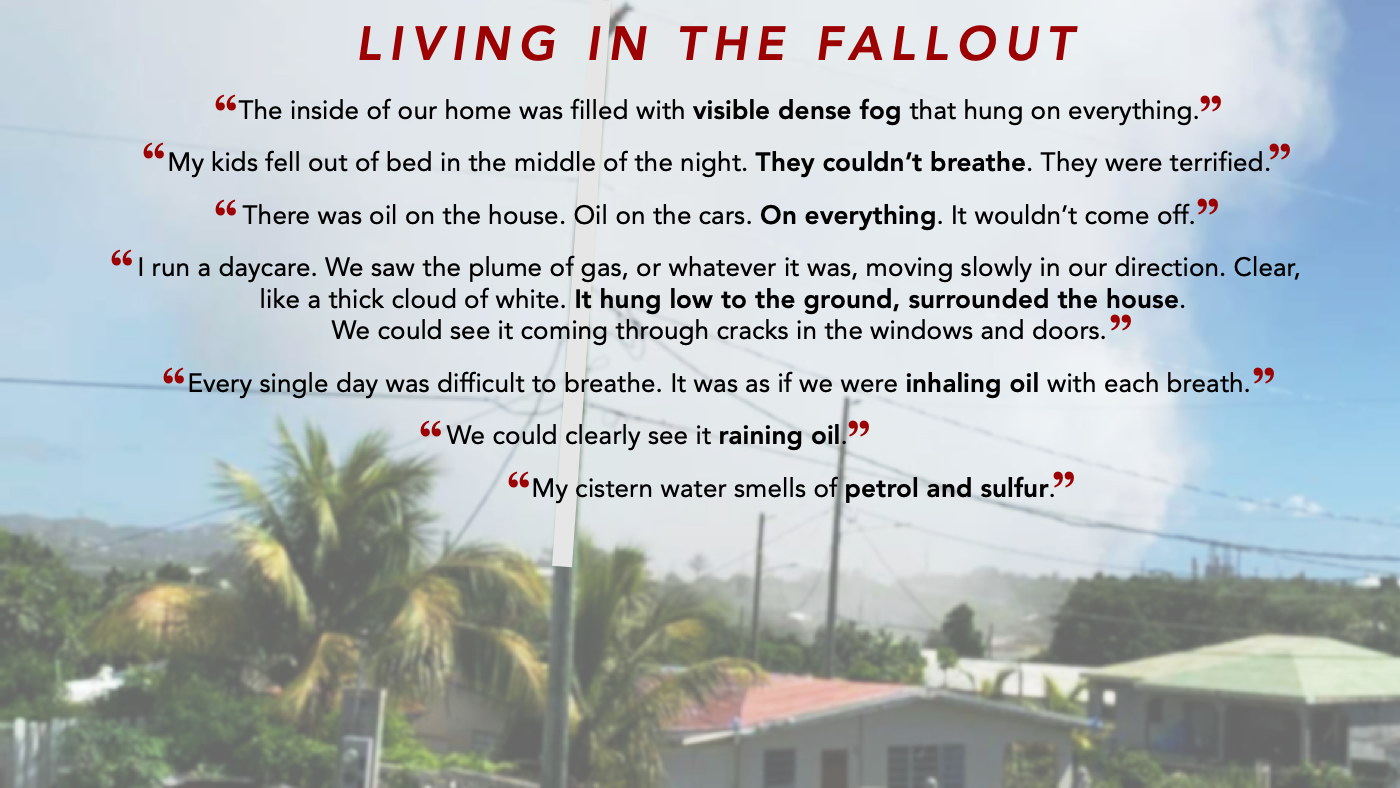
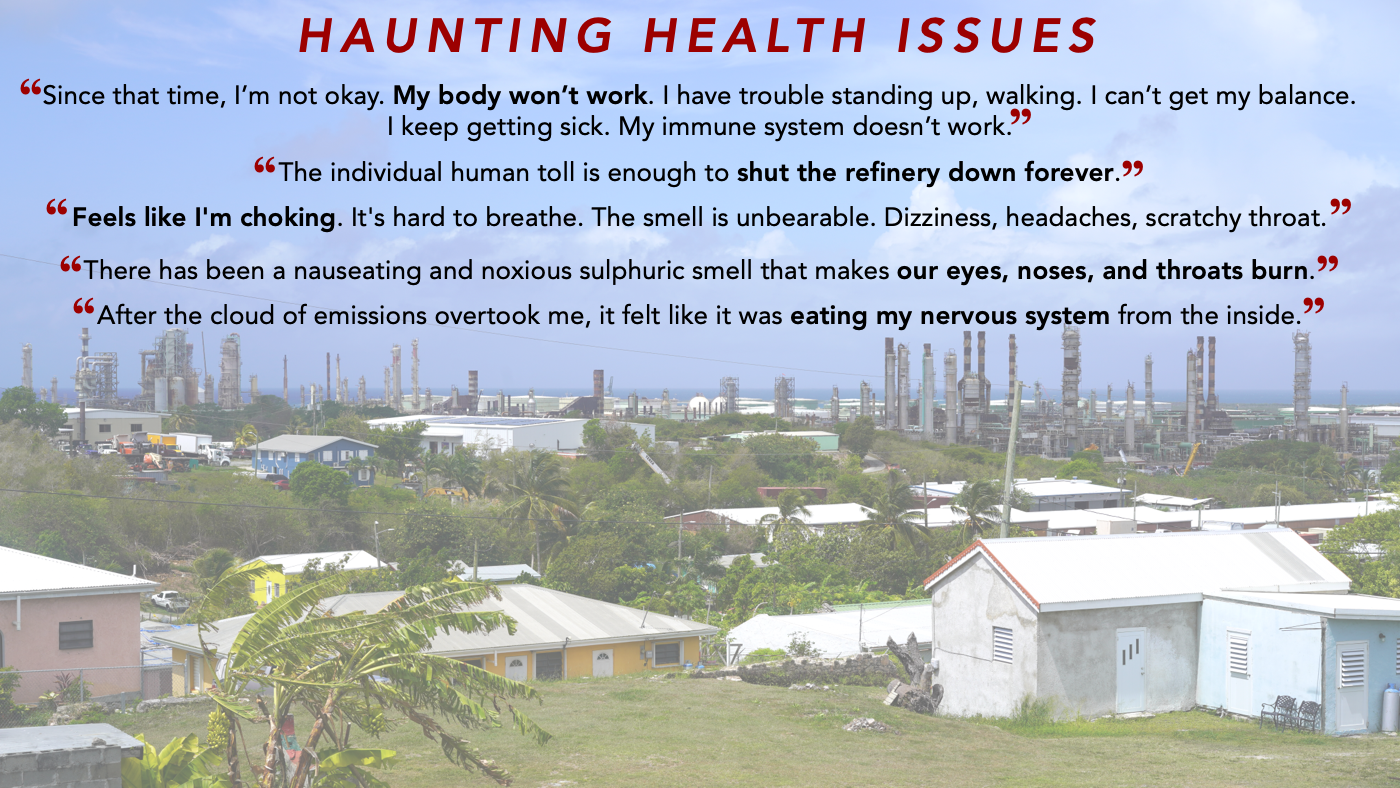
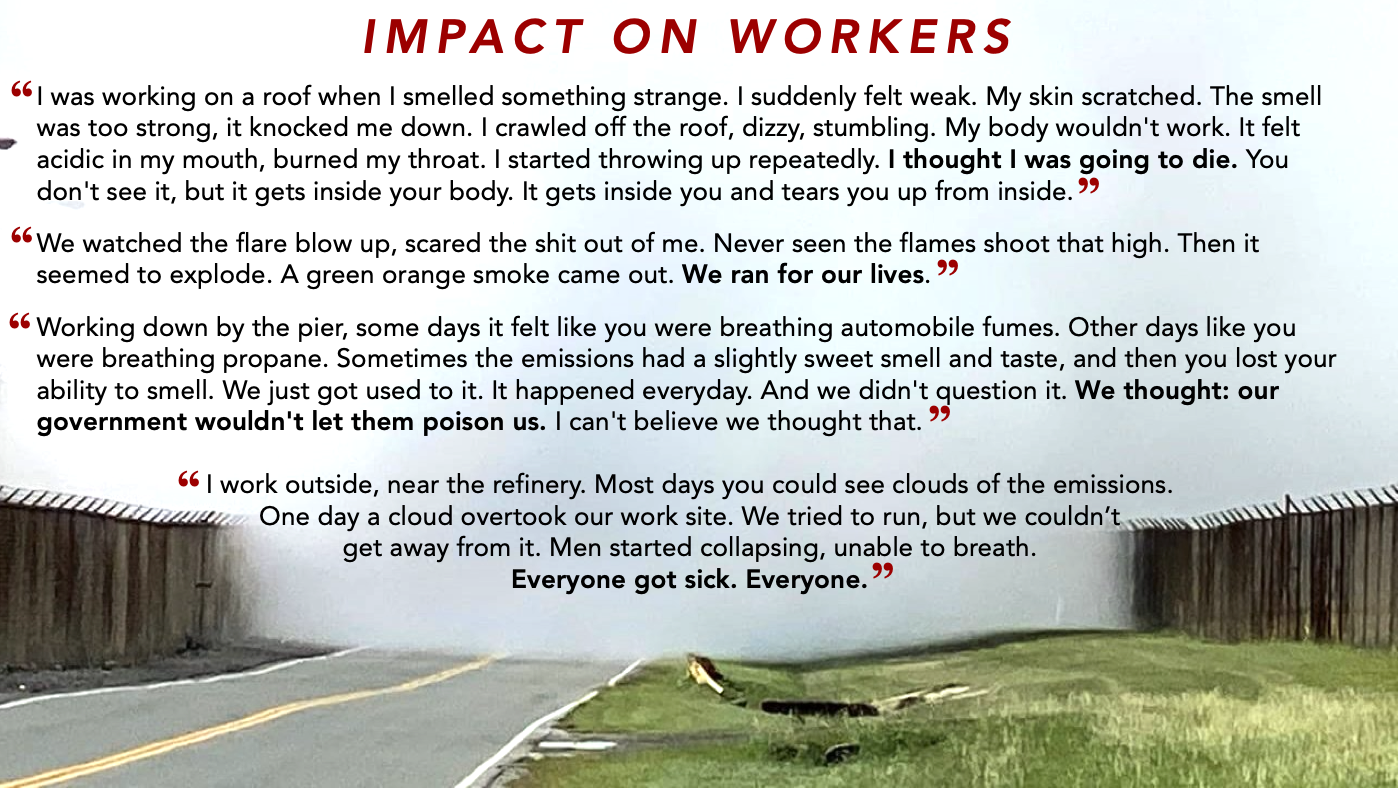
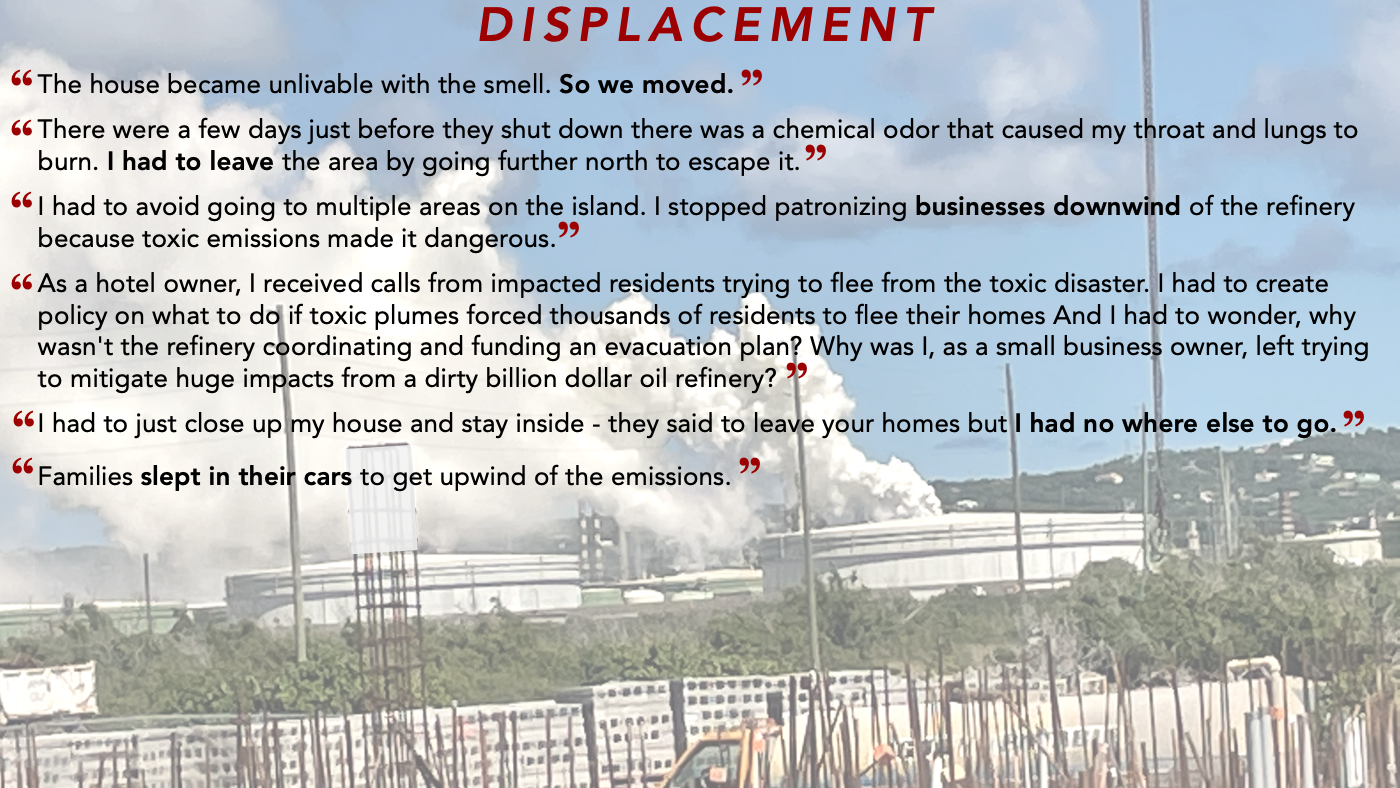
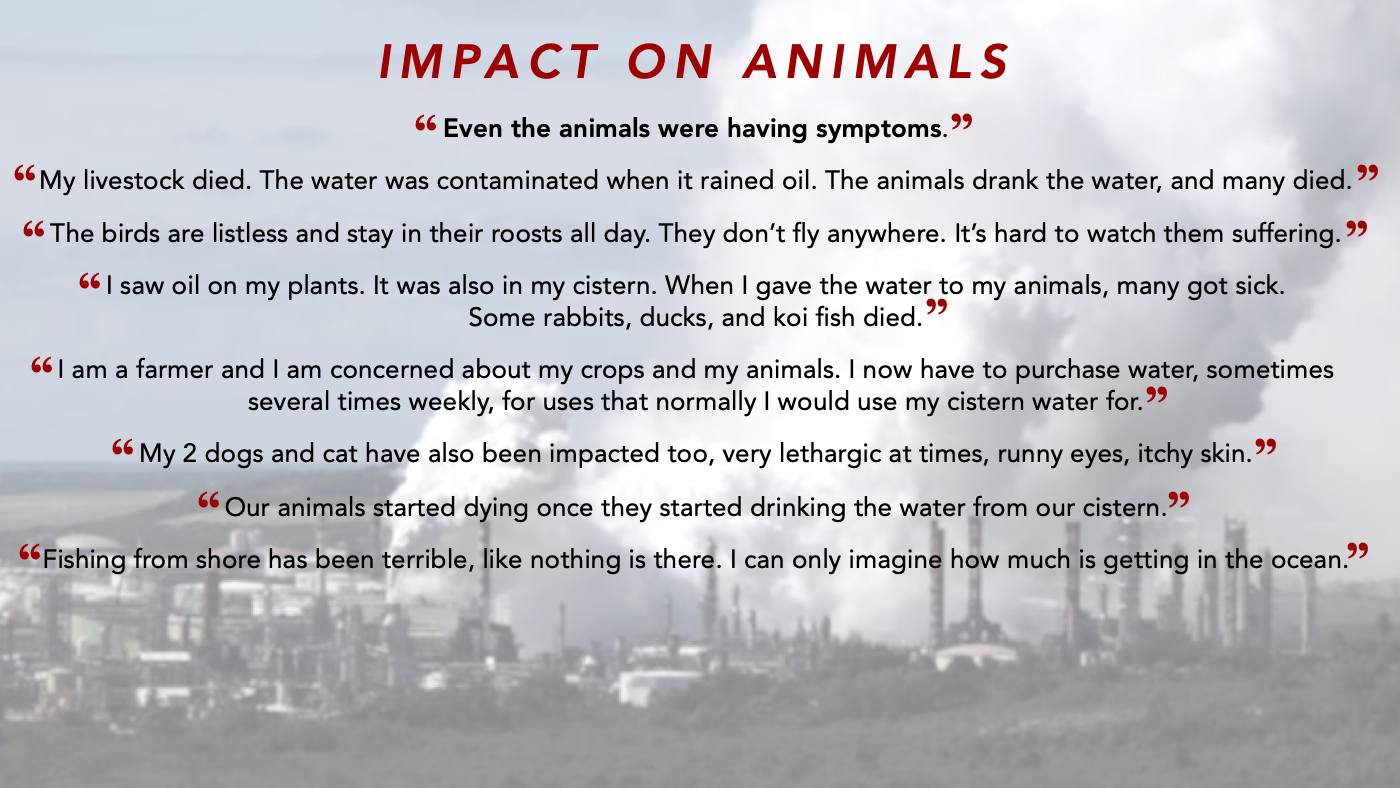
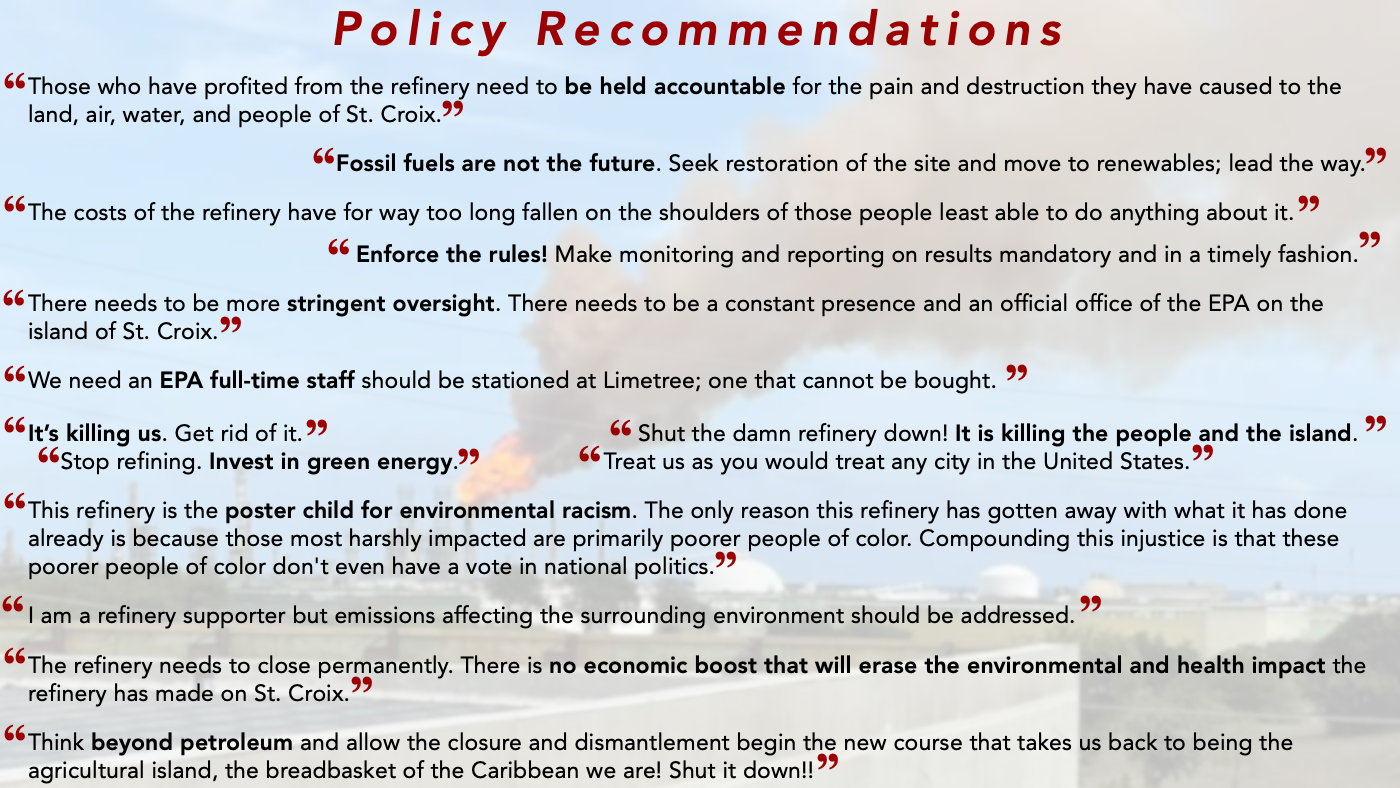
WHAT WE FOUND IS ALARMING
After being closed for nearly a decade, the massive Limetree Refinery on St. Croix in the US Virgin Islands was rushed back into operation in early 2021. In a time of strained government budgets, the promised windfall of the refinery helped brush aside standard industry safeguards, previous environmental settlements, and the extra vigilance pledged to marginalized communities.
What happened in that permitted absence of sensible oversight? For many residents of St. Croix, the restart of the Limetree Refinery was an unmitigated environmental disaster. In response to community concerns over the impacts of the refinery and worry that widespread damages to health and home were being deliberately kept out of public view, this past summer we conducted a community survey to gather together the insights of residents living downwind of the refinery.
What we found is alarming. Our Community Impact Survey found widespread environmental and health impacts from the troubled restart of the Limetree Bay Refinery (formerly HOVENSA). Most of these impacts have not been previously reported and many have not been formally acknowledged by the refinery, the territorial government, and federal agencies.
The biggest finding of this survey? Every single neighborhood to the North and West of the refinery reported significant environmental and health impacts from the droplets of crude oil that routinely rained down on homes and farms, from the thick clouds of petrochemicals that crept into classrooms and bedrooms, and from asphyxiating emissions that strangled residents on a near daily basis. Approximately 20,000 people live downwind of the Limetree Refinery in St. Croix.
Impacts were severe in predominantly low-income Black and Brown neighborhoods directly downwind of the refinery. Despite multiple calls to the refinery and government agencies requesting assistance, many households in these neighborhoods are still waiting for help months after their cisterns were contaminated, their gardens fouled, and their health impaired.
In West End neighborhoods, hundreds of residents described noxious odors that left them gasping for breath or stricken with debilitating headaches on a daily basis in April and May. In Kingshill neighborhoods, hundreds of residents described low-lying chemical clouds that crept through windows and doors to infiltrate their homes. Many residents also described how incomplete flaring splattered petrochemicals and crude oil on their cars, cisterns, and gardens repeatedly in February, April, and May.
Over 100 households across the West End reported emissions and petrochemical rains that injured their gardens. After acute emissions episodes, some reported their vegetables and fruit trees shriveled up, impacts that are consistent with deadly levels of sulfur dioxide gas. Many residents downwind of Limetree described nightly emissions so bad they woke everyone in the household, sometimes with sudden nausea and vomiting and sometimes with the terror of being unable to breath.
Alongside widespread damages to homes and daily struggles to breathe in poor communities of color, this survey also uncovered three untimely deaths that friends and family members ascribe to toxic emissions from the refinery.
Most of these impacts have not been officially acknowledged or investigated. Nor, since Limetree Refinery filed for bankruptcy in July, has there been any real effort to address the contamination that can still be found drinking water cisterns that smell of diesel, that can still be heard in hoarse voices seared by acrid emissions, and that can be seen in men, women, and children still unsteady from the neurological fog of toxic exposures.
PRESS RELEASES
Collecting data by going door-to-door in neighborhoods, standing outside grocery stores and community centers, and encouraging online participation, this 26 question survey gathered information from residents across St. Croix from June 17 to July 11, 2021. In three weeks, this survey generated 681 unique responses from 120 different neighborhoods across St. Croix. This survey was organized by Professor David Bond (Bennington College), Frandelle Gerard (CHANT), Sommer Sibilly-Brown (VI Good Food Coalition), and Jennifer Valiulis (St. Croix Environmental Association).
PRESS RELEASE (December 17, 2021) >>
PRESS RELEASE (July 14, 2021) >>


Previous Press Releases
PRESS RELEASE (Response to Limetree closing: June 22, 2021) >>
PRESS RELEASE (Survey Launch: June 17, 2021) >>
PRESS CONFERENCE (June 17, 2021) >>
Local and National News Coverage of Limetree Refinery
TROUBLED RESTART OF LIMETREE
- Inside Climate News, “Donald Trump’s Parting Gift to the People of St. Croix: The Reopening of One of America’s Largest Oil Refineries” (March 21, 2021)
- Washington Post, “The Island Where it Rained Oil,” (March 25, 2021)
COMMUNITY IMPACT SURVEY
- St. Croix Source, "Survey Seeks Residents Input on Recent Limetree Emissions" (June 17, 2021)
- VI Daily News, "St. Croix Residents Urged to Take Online Survey on Impact of Refinery Pollution" (June 18, 2021)
- The St. Thomas Source, "Survey Organizers say Early Data Shows Widespread Health Impacts from Limetree" (June 22, 2021)
- Analyze This, “Interview with Sommer Sibilly-Brown and David Bond,” (June 23, 2021)
- The Mario Moorhead Show, “Interview with David Bond,” WSTX (June 23, 2021)
- Keeping it Honest Show, WSTX AM 970, “Conversation with Governor Albert Bryan, Sommer Sibilly-Brown, and David Bond,” (June 26, 2021)
- The St. Thomas Source, "Criminal Investigation into Limetree Called For" (July 14, 2021)
SHUTDOWN & BANKRUPTCY OF LIMETREE REFINERY
- Reuters, “Private Equity Bet on Troubled Caribbean Refinery Blows up on Retirement Funds,” (June 3, 2021)
- The Washington Post, "Controversial St. Croix refinery ceases operations given ‘extreme financial constraints’" (June 21, 2021)
- Associated Press, “USVI Oil Refinery to Shutter Indefinitely Amid Violations” (June 21, 2021)
- Reuters, “Troubled Caribbean Refinery Seeks Bankruptcy as Lenders Balk at Injecting More Cash,” (July 13, 2021)
- The Washington Post, "St. Croix refinery files for bankruptcy amid mounting complaints from residents" (July 14, 2021)
BANKRUPTCY PROCEEDINGS AND ST. CROIX ENERGY
- Wall Street Journal, “Limetree Refinery Wants Shield Extended to Private-Equity Backers,” (July 26, 2021)
- The St. Thomas Source, “Let’s Go Save a Refinery,” (August 13, 2021)
- Wall Street Journal, “Lead Bidder Offers $20 Million Aiming to Restart Virgin Islands Refinery,” (Nov 15, 2021)
- Reuters, “Limetree Bay Refinery Sold for $20 Million to St. Croix Company Eying Restart,” (Nov 18, 2021)
- The St. Thomas Source, “St. Croix Energy Wins Bid for Bankrupt Limetree Bay Refinery,” (Nov. 18, 2021)
- Patricia Borns, “St. Croix Energy Faces Uphill Battle to Close and Restart,” (Nov 24, 2021)
- Virgin Islands Consortium, “Cane Bay Partners’ David Johnson is Largest Shareholder in St. Croix Energy,” (Nov 24, 2021)
- Bloomberg News, “Payday Lenders at Play on Caribbean Yachts,” (Sept 11, 2014)
WHAT HAPPENS NEXT? CRUCIAN VISIONS FOR A MORE SUSTAINABLE FUTURE
- St. Thomas Source, “Crucian Groups Call for Action to Self-determine their Economic Future” (July 31, 2021)
- St. Croix Foundation, “Rebuild Differently: Not Just New Infrastructure But New Systems” (November 2019)
- NRDC, “On Island Where it Rains Oil, a Chance to Reimagine St. Croix” (July 27, 2021)
PUBLIC HISTORY OF LIMETREE REFINERY
- David Bond, “After Oil,” Anthropology News (April 22, 2020)
- David Bond, “Crude Prosperity: Part One,” St. Croix Source (June 5, 2021)
- David Bond, “Crude Prosperity: Part Two,” St. Croix Source (June 15, 2021)
SCHOLARLY HISTORY OF REFINERY ON ST. CROIX
- David Bond, “Oil in the Caribbean,” Comparative Studies in Society and History (June 2017)
- Matthew Johnson, “Black Gold of Paradise: Negotiating Oil Pollution in the US Virgin Islands,” Environmental History (Oct 2019)
Summary of EPA and OSHA Investigations into Limetree
The Limetree Refinery “experienced multiple major mishaps” in the first five months of 2021, as the EPA later put it in an emergency order to shutdown the facility for “presenting an imminent and substantial endangerment to public health.” Far from a deviation, this latest wave of cascading accidents stands as the latest chapter in a much longer history of skirting environmental law, ignoring standard industry safeguards, and habitually sacrificing public health on the altar of promised economic returns.
For much of the past 60 years, the Limetree (HOVENSA) Refinery was the largest oil refinery in the world. The refinery has a long history of environmental harms on St. Croix. The refinery closed abruptly in 2012 to elude $700 million in mandated investments to bring the facility into compliance with environmental law. Under the Trump Administration, this liable history was brushed aside in a rush to bring the refinery back online, bolstered by an EPA that prioritized the economic promise of the refinery over its environmental history of neglect. (As has been previously reported, under Trump, EPA Region Two was reorganized as a “customer service” agency for this mammoth refinery).
As the refinery sputtered back online in February, uncontrolled flaring and toxic emissions assaulted residents of St. Croix. In defiance of its permits, the Limetree Refinery refused to operate fenceline monitoring equipment and kept relying on a malfunctioning flare unit to process dangerous emissions. The horrifying situation that followed was sadly predictable: the refinery coughed up thick clouds of oil that showered homes and farms in petrochemicals while unchecked emissions strangled entire neighborhoods on St. Croix. In many low-income Black and Brown communities, these attacks on their health became a daily occurrence between February and May.
From January 2021 to May 2021, residents of St. Croix cried out for help, begging the refinery, the territorial government, and the EPA to please step in and stop the toxic assault on their lives. As this stream of complaints entered its fourth month, the EPA finally sent staff to St. Croix to investigate Limetree in early May.
On May 6th, an EPA on scene coordinator pulled his car over near the refinery and rolled down the window. “The odor I briefly encountered was overwhelming and nauseating.” He felt sick immediately, and struggled with a “cloudy head” all day. “It was obvious to me the odor was emitting from Limetree.” One week later, the EPA drew on its emergency powers to order Limetree shutdown.
An EPA report revealed Limetree was run in open defiance of standard industry safeguards and with a flippant disregard for public health. The near daily disarray at Limetree narrowly avoided becoming a mass casualty event.
The EPA determined that a faulty flare had repeatedly released an oily mist into nearby neighborhoods, coating homes and farms with droplets of crude oil and a sheen of petrochemicals. On a Caribbean island where most households rely on rain catchment systems, unchecked refinery emissions are a drinking water crisis. But beyond contaminating thousands of cisterns, the EPA noted these oily mists posed a more nightmarish threat: “flaming rain.” While such an incident did not occur, the EPA investigation explained that clouds of oil droplets can ignite and “rain down while on fire in the refinery and nearby neighborhoods,” potentially introducing catastrophic firestorms. This kind of fallout, the EPA noted, “is not common for a refinery startup.”
The EPA report also documented the uncontrolled release of deadly sulfurous gases from the Limetree Refinery.
Sulfur dioxide (SO2). Limetree Refinery has acknowledged the refinery released worrisome levels of sulfur dioxide during the early months of 2021. Subsequent EPA models determined those releases of sulfur dioxide gases likely posed an “imminent and substantial danger” to public health on St. Croix. Releases of sulfur dioxide, the EPA wrote in its report on Limetree, “is considered immediately dangerous to life and health.” As ATSDR summarizes, “short-term exposure to high levels of sulfur dioxide can be life-threatening,” and low-level exposures have been linked to a host of debilitating respiratory issues.
How much sulfur dioxide was released by Limetree? Nobody knows for sure. While HOVENSA previously operated five fenceline SO2 monitors at this facility, Limetree declined to conduct any SO2 monitoring in open defiance of the requirements of its operating permits. (The EPA eventually issued a notice of violation for this lapse in late April, but for many residents that preliminary enforcement came months too late). Limetree now admits deadly sulfur dioxide was released in at least one flaring episode, but told EPA it “does not know how much SO2 was emitted.” Why? Because there was no monitoring equipment available to measure those emissions.
Hydrogen Sulfide (H2S).
Limetree also later admitted to the EPA that it had released deadly levels of hydrogen sulfide gas. At the refinery, Flare #8 was bound by strict emission standards for hydrogen sulfide that limited releases to 162 parts per million (on rolling three hour averages). Exceedances of this threshold became a routine occurrence at Limetree. During one flaring incident in April, hydrogen sulfide levels skyrocketed to 91,649 parts per million, or “over 565 times higher than the concentration of 162 ppm,” as EPA put it. The National Institute for Occupational Safety and Health (NIOSH) determined that hydrogen sulfide levels over 100 ppm are “immediately dangerous to life or health of workers.” ATSRD notes that “the respiratory tract and nervous system are the most sensitive targets of hydrogen sulfide toxicity” and that “just a few breaths of air containing high levels of hydrogen sulfide can cause death.”
The egregious release of hydrogen sulfide from Limetree in April did not pass without public notice. In late April, residents across the West End of St. Croix complained of sulfurous emissions that caused respiratory distress, headaches and balance problems, and severe vomiting. On April 23, the Virgin Islands Department of Planning and Natural Resources (DPNR) said its air quality team had detected hydrogen sulfide released from the refinery. In a statement, DPNR said: “Limetree Bay is experiencing an exceedance of hydrogen sulfide..” The next day, Limetree issued a quick clarification: “The refinery did not experience a gas leak of hydrogen sulfide.” Hydrogen sulfide was “safely burned in the flare,” generating emissions that contained an unpleasant odor but were “far below the level normally considered dangerous to health.” In other words, Limetree lied. As Limetree amassed growing evidence that hydrogen sulfide levels were overwhelming its flaring systems and surpassing levels considered deadly, leadership at the refinery continued to dismiss local complaints of noxious odors and assure the community that nothing was wrong.
When the Virgin Islands Department of Planning and Natural Resources (DPNR) first detected hydrogen sulfide, it warned residents living downwind of the refinery in April 2021: “Exposure to low concentrations of hydrogen sulfide may cause headaches, poor memory, tiredness, and balance problems. Brief exposures to high concentrations of hydrogen sulfide can cause loss of consciousness.” DPNR recommended people with respiratory issues such as allergies or asthma should consider temporarily “relocating to areas less affected” by refinery emissions. How low-income Black and Brown families living downwind of Limetree might afford to temporarily relocate was not discussed.
Nor were risks only distributed outward. In the four months the refinery was operating, OSHA issued 20 serious violations of workplace safety at Limetree. OSHA defines a serious violation as a workplace hazard that “could cause an accident or illness that would most likely result in death or serious physical harm.”
For many residents, the EPA’s emergency order to close the refinery came four months too late. Among the citizens we’ve spoken to there is a widespread sentiment: these Black and Brown communities feel under assault by Limetree’s environmental negligence and abandoned by federal agencies tasked with protecting their health.
Hundreds of homes and gardens remain contaminated with petrochemicals that rained down from Limetree emissions. And many individuals across St. Croix now live with lasting respiratory issues, neurological impairments, and other serious medical ailments they attribute to emissions from Limetree. Many of these injured individuals have been ignored by agencies tasked with protecting public health, and are now paying for the significant medical care they now require out of pocket. Victims of toxic pollution should never have to pay for their own medical treatment.
The data amassed by our Community Impact Survey confirms the severity of toxic releases documented by EPA and OSHA investigations, and offers a troubling window into just how widespread the fallout of this environmental disaster was for the people of St. Croix.
Background on Caribbean Refineries
During the 20th century, the Caribbean was remade as a vital conduit of cheap petroleum for the American Empire of Oil.
Entrepot oil refining has a long, if understudied, history in the Caribbean. As the Panama Canal brought new shipping lanes to the region and as European navies retrofitted their fleets to run on petroleum, oil refineries were built across the Caribbean in 1930s and 1940s. During World War II, the Royal Dutch Shell refinery on Curaçao became the largest refinery in the world, followed closely by Standard Oil of New Jersey’s refinery on Aruba. By 1970, half of all crude oil imported to the US passed through the Caribbean Sea on supertankers. With deep ports and pliable governments all too willing to exempt new oil refineries from environmental oversight and workers rights, US oil companies soon found themselves building massive enclave refineries to service the growing American addiction to foreign oil. By far, the biggest of this new generation of Caribbean refineries was built by Hess Oil on St. Croix, USVI.
The peripheral quality of the Virgin Islands has long camouflaged their imperial centrality to the energy networks of the US. For the better part of the past century, this Caribbean outpost of US Empire was home to the world’s largest oil refinery and the major source of cheap gasoline to the Atlantic Seaboard. Yet even as the mammoth scale of this refinery single-handedly shaped national petroleum markets, its location in the Virgin Islands has often confused effective oversight. For decades, this entrepot refinery operated in open defiance of workers rights, environmental protections, tax law, and safeguards for public health. When problems occurred it often took EPA, OSHA, and other federal agencies weeks to send staff and equipment to investigate, if they showed up at all.
This paradox of being at once big and small, near and far, domestic and foreign is not only fundamental to life in the territories of the United States, it is also a paradox that underwrites the American Empire of Oil.
After World War II, abundant reserves of crude oil in California, Oklahoma, and Texas underwrote a new American Dream of cheap food, big cars, and suburban ease. As the domestic flow of crude started contracting in the 1960s, the nation faced a dilemma: either recognize natural limits to energy or compel oil from elsewhere. The United States debated whether to redesign American life around alternative sources of energy, efficiencies achieved through public investments in building design and transportation, and drastically curtailed military expenditures of fuel (all of which were key platforms of the first Earth Day in 1970). Or, in the other direction, whether to throw the weight of the federal government into a more imperial pursuit of foreign oil. President Richard Nixon, opting for the latter, helped deepen the American addiction to fossil fuels far beyond what the country itself could provide. American domestic oil production peaked in 1970 (until the recent fracking boom reversed the downward trend), a fact that made the energy network of the United States newly attentive to foreign oil. In 1955, roughly 90% of the petroleum consumed in the United States came from domestic sources. By 1977, roughly half of the gasoline, jet fuel, and heating oil consumed in the US came from foreign oil.
This rising American dependence on foreign oil transformed the Caribbean into the premier refining hub of the eastern United States. With domestic refineries hedged in by urban sprawl, labor union demands, and new environmental regulations, many American oil companies realized the exceptional advantage of the Caribbean. And soon Tesoro, Sun Oil, Gulf Oil, Union Carbide, Phillips Petroleum, Hess Oil, and others were fast at work building new offshore enclave refineries to service the American addiction to fossil fuels. The Caribbean found itself recast as an imperial outpost of American energy: close enough for the U.S. to monopolize the gain but far enough away to avoid any real responsibility for the problems.
Between 1950 and 1990, oil refineries became the largest site of capital investment in the Caribbean, a leading source of state revenue, and one of the region’s largest employers, especially during the construction boom of new refineries in the late 1960s and early 1970s. This petro-boom renovated older refineries in Aruba, Curaçao, and Trinidad and built new entrepot refineries in Antigua, the Bahamas, Puerto Rico, and the Virgin Islands. Accepting delivery of oil from around the world, these refineries only processed crude in one direction: north to US markets. By 1980, the Caribbean had become the world’s largest exporter of refined petroleum products in the world, almost all of which went to the United States. By some estimates, one out of every six gallons of gasoline sold in the United States had been processed at a Caribbean refinery.
That window of unregulated (and unscrupulous) oil refining in the Caribbean is drawing to a close. Climate change is removing the ecological and ethical distance imperialism imagined it could maintain. In the past decade, nearly every enclave Caribbean refineries closed. The past two decades shuttered four enclave refineries in Puerto Rico and 2012 witnessed the closure of the Valero Refinery on Aruba and the HOVENSA (Hess) Refinery on St. Croix, USVI. Five years later brought the last entrepot refinery to its knees: the sprawling Pointe-a-Pierre Refinery in Trinidad and Tobago closed in 2018. After decades of a Caribbean vacation from the rules, the political geography of oil refining swung back towards the Gulf Coast of the US (and its glut of cheap natural gas from fracking to power to the refining process) at the same time the tremendous ecological devastation unleashed by these Antillean refineries is beginning to catch up with these islands. Enclave refineries may have been insulated from spilling the wealth of oil locally but they were always generous in spilling the problems. Extensive contamination of groundwater, coastal mangrove estuaries, and air has left many refinery sites with decimated fisheries, poisoned aquifers, and sprawling properties at prime coastal locations whose still simmering toxicity prevents any easy repurposing. Many Caribbean islands that once linked their future prosperity with the imperial petroleum networks of the United States are finding themselves further isolated from that receding promise. At the same time, petroleum authored climate change is amplifying the intensity and frequency of hurricanes across the Caribbean region. The negative ecologies of fossil fuels now assail the Caribbean from two sides: a catastrophic history of profitable neglect and a catastrophic future of climate instability.
In this broader reckoning with the toxic legacy of oil refining in the Caribbean, the US Virgin Islands stands alone in its singular obsession with rebooting oil refining as the only economic engine capable of pulling the island through the coming storms.
(by David Bond)



This website was designed by Bennington College students Ahmad Yassir ‘20, Ahwar Sultan ‘22, Cedric Lam ‘22, Elinor Phillips ‘22, Hanna Karnei ‘21, and Prof. David Bond.
For more information, please contact David Bond (dbond@bennington.edu)